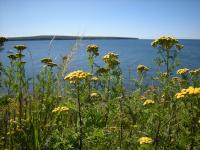What's Working for Conservation
General Invasive Species Control Information
MIPN: The MIPN Control database: allows people to select a plant they want to control, indicate the type of habitat it is in, whether or not they are professionals or novices, etc. and the database comes back with specific chemical, mechanical, and/or biological methods.
MnDOT: MnDOT (pdf) has a new noxious weed booklet providing weed control recommendations.
DNR: The DNR’s invasive species web pages have undergone some reorganization and updating. PlayCleanGo is a new outreach effort to increase awareness about invasive species.
Biological Control: Biological control, the use of natural enemies to control non-native pests, can be an effective tool in managing invasive plants. Non-native plants can become invasive because they lack the insects and diseases that control them in their native environments. Biological control reunites natural enemies, such as herbivores and pathogens, with their host (invasive plant) to reduce impacts caused by the pest. The goal of biological control is to reduce the target pest population and its corresponding impact to an acceptable level. The Minnesota Departments of Agriculture (MDA) and Natural Resources (DNR) have implemented successful biological control programs for leafy spurge, spotted knapweed, and purple loosestrife statewide. Development of new biological control efforts for garlic mustard, buckthorn and common tansy are underway. Our programs utilize specialized insects that were tested extensively for host specificity (safety) and efficacy. Biological control programs in Minnesota are cooperative. Multiple agencies, associations, institutions, and private landowners work together to accomplish goals. Lead agencies help to coordinate efforts, disseminate information, provide expertise, and collect data (Monika Chandler, Minnesota Department of Agriculture).
Sentence to Serve: We have gotten a lot of help in maintenance of public park restorations in from the Sentence-to-Serve program that is part of the County Sheriff Department. The crews have helped with such work as dragging cut buckthorn, pulling mullein, root chopping sweet clover and bird’s-foot trefoil and more. This helps to keep the project cost down considerably (Gina Hugo, Sherburne SWCD).
CWMAs: The following webpages provide valuable information about Cooperative Weed Management Areas and invasive species control.
- IPAW - www.ipaw.org note it includes a section on CWMAs called "Regional invasive plant groups". Also includes archives of our newsletters with articles on ongoing projects. Our extensive reed canary publication is also on this site. The nursery/consultants list that is on there is a bit out of date. We'll be updating it this winter.
MIPN: The Midwest Invasive Plant Network website www.mipn.org provide a wide range of valuable information including publications, power points and conference abstracts
Pope County CWMA: Information about invasive species control information from the Pope Cooperative Weed Management Area can be found at: http://weedwatchers.org/index.cfm/pageid/65

